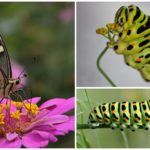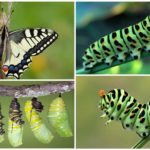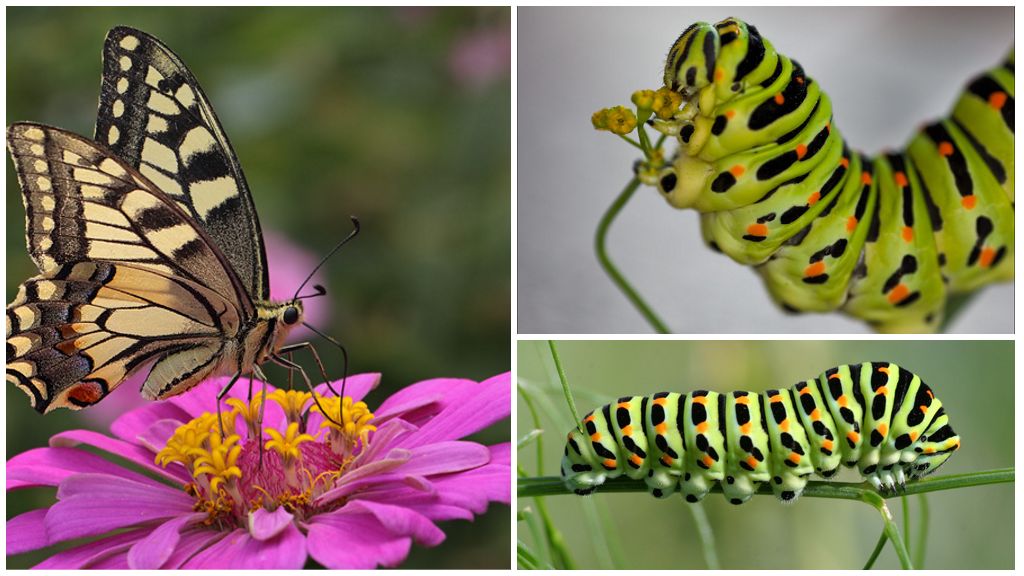Description and photo of the caterpillar of the Machaon butterfly
- Swallowtail caterpillar
- Swallowtail caterpillar
The caterpillar of the Machaon is no less attractive and unusual than its butterfly. They are ubiquitous and completely harmless to humans. You can meet representatives of the family in Russia, Belarus, many regions of Europe, as well as Asia, Africa and America.
Caterpillar development
The mating season at Machaon falls at the end of spring. But, given the wide range of habitat, this period can move in any direction, due to different climatic conditions of habitats. The first generation of caterpillars appears in May-June, and the second from August to September. General developmental time from egg to imago takes about 2 months.
A week after laying of very small yellow eggs, small caterpillars are born. Swallowtail larvae belong to those types of tracksthat change their color in the process of development. The first few days are just black individuals with white and red spots on their bodies. But after 3-4 days, black stripes are already visible on them and an orange color appears.
Grown green individual with peppered stripes. Each strip has a black oblong spot and several small orange blotches.
On a note!
The pupae of the first generation will turn into an adult in 15-20 days, and the second will winter. Their period of transformation is several months.
Nutrition
The caterpillar of the Machaon butterfly is very voracious and begins to eat immediately after birth. She needs to collect a large amount of nutrients, which in the future will give strength to become an adult beautiful butterfly.
On a note!
Beloved food caterpillars Mahaona are representatives of the umbrella family.Individuals eat dill, fennel, parsley, carrots, dagil, cumin, buten and cow parsnip. But if none of the above is found, they will eat wormwood, spruce and alder. The insect's appetite is markedly reduced immediately before pupation.
The color of the pupa may also vary depending on the habitat and climatic conditions. The most common are greenish or yellowish with a pattern in a small black dot. But sometimes you can see dark brown and even brown pupae.
Caterpillar protection methods
These cute insects have a sufficiently large number of natural enemies. The situation is complicated by the fact that less than a century ago, people considered the Makhonians dangerous pests and tried their best to exterminate them. As a result, the population decreased markedly.
Important!
Mass deliberate destruction of members of the family Machaon led to the fact that this species was listed in the Red Book.
This butterfly larva does not refer to poisonous caterpillarsher method of defense is scaring. In case of danger, the swallowtail caterpillar pushes the special gland forward. It is located behind the front of the head and looks very similar to the small red horns. These horns are called osmetry.In the photo of the swallowtail caterpillar one can clearly define that it is preparing to repel the attack and has taken a hostile position.
The front part of the body rises and a bright orange-yellow liquid with a strong, specific odor is released from osmetry. It is he who is called to repel enemies and provide protection to individuals. Adult butterflies glands do not use and flee.
Growing at home
The development of trade allowed to sell even the eggs and pupae of the Machaon. In the online store you can purchase the right amount of eggs and try to grow adult ones out of them.
- To do this, you need to equip a small container, and a plastic bottle will do.
- A foam pad is laid as the basis and the feed is laid out.
- Eggs lay out on plants. In a few days, caterpillars will appear from them. It is important to ensure that they have enough food.
At observance of the specified recommendations individuals quickly mature and change their color. After that, you will need to prepare a place for pupation. For this, the pupae need a rough surface. Only on it will they be able to firmly establish themselves.
Pupae should not be attached to the smooth walls of the container. They can not sustain their own weight and fall. If during this time the butterfly does not have time to open its wings, it can be badly damaged and die.









